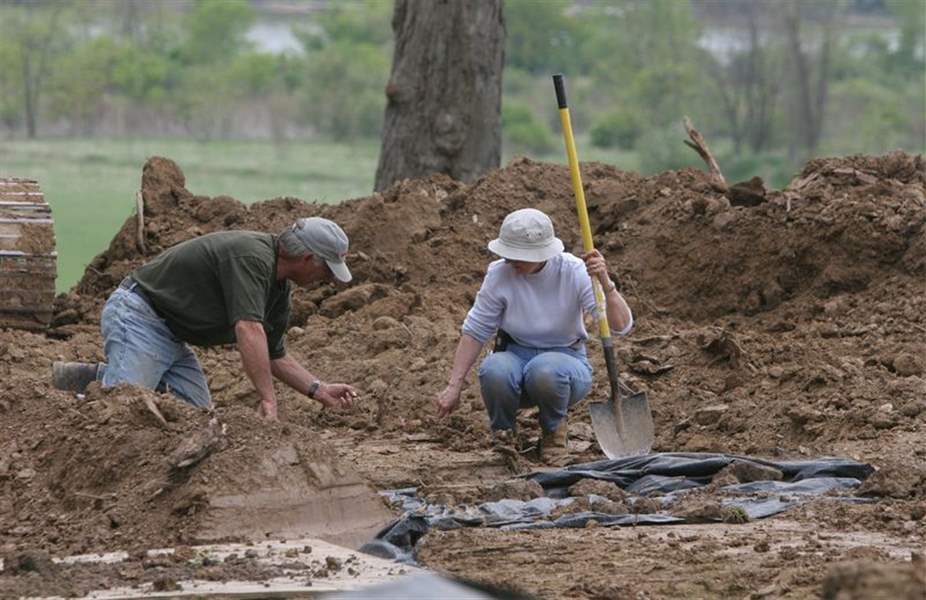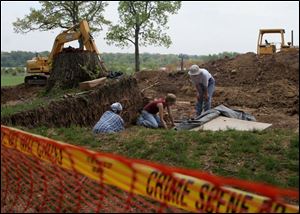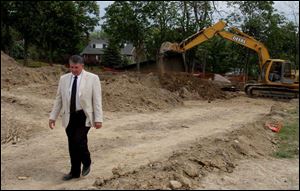
As more remains are found, the mystery widens
5/15/2005
Gary Borton and Patty Croninger look for evidence of grave sites at the former Miami Children's Home in Maumee last week.
lisa dutton / blade

Kate Hayfield, left, Rachel Davies, and Patty Croninger work at uncovering the remains of a grave site at the former Miami Children's Home on River Road last week.
Crouched in a shallow pit, Kate Hayfield and Rachel Davies daily sift through dirt, layer after layer, careful not to miss even the smallest bone or perhaps something as common as a button.
Piece by piece, the archaeologists with the Mannik & Smith Group of Maumee pick out the aged bones. By hand, they place the remains in bags for further study.
For weeks, local archaeologists have been searching the northeast corner of the former Miami Children's Home property at 2500 River Rd. in Maumee - a search that began after portions of a human skeleton were discovered on the site by crews excavating for a new upscale housing development.
What began with the discovery of an African-American woman's remains now has become a larger mystery. As of late last week, 40 complete graves were unearthed.
To date, the skeletons have not been identified, the extent of the burial ground has not been determined, and no one has produced a record showing that a cemetery ever existed.
The graves were apparently the resting place of adults, children, and infants. Most likely the burial ground was for the poor, said G. Michael Pratt, head of the archaeological team hired by the county.
"Cemeteries of people of means don't usually get lost because of the markers that were used, usually stone," Mr. Pratt said. "But if you in essence have a field with tomato sticks with numbers on them, it's easy to see how it would get lost."
The Maumee discovery is not unusual. Forgotten cemeteries are often found during construction projects, decades after the last of the wooden markers has disintegrated. Backhoes working to make room for foundations and bulldozers moving earth have been known to dig up human bones instead.

Gary Borton and Patty Croninger look for evidence of grave sites at the former Miami Children's Home in Maumee last week.
Several such discoveries have been made in the Toledo area in recent years:
And according to an April 29, 1956, article from The Blade, an old burial ground containing bones of what were believed to be early settlers of the Fort Miami area was found on the grounds of the Miami Children's Home by workers who were laying a drainage tile.
The article - a publicly available copy of which was found in the Toledo-Lucas County Public Library's local history section - reported that the eight graves discovered were reburied on the orders of Dallas V. Wentz, superintendent of the home.
The article proved interesting to Mr. Pratt, who said that the ground showed evidence of a trench being dug near the site, only to be stopped and redirected. He added that the decision to basically forget the cemetery again showed how different attitudes toward burials existed then - as well as today - in various areas of the world.
"Because most people today are buried in private cemeteries, where you pay for a plot, you have this idea that your relatives are being interred forever," he said. "That's not always the way people have thought about cemeteries."

G. Michael Pratt, who heads the archaeological team hired by the county, walks through the grounds, where an upscale housing development is planned and where graves continue to be discovered. Mr. Pratt says the discovery of long-forgotten cemeteries is not that unusual.
Unexpected discoveries of burial sites halt work and ignite a flurry of speculation. In Maumee, archaeologists were called in to determine the size of the burial ground and forensic anthropologists were asked to identify the race and gender of the remains.
Although they have not begun their work, Toledoans Frank and Julie Saul - forensic anthropologists who have worked sites from the World Trade Center to Panama - will examine the remains to determine who they are and when they died.
So far, however, it is the local history buffs who have taken on the job of digging up records that may shed light on what sort of burial ground it is. To date, many of the clues have led to dead ends.
"When they determine how old it is, it will be easier to determine what kind of cemetery it was and who is there," said Marilyn Wendler, who has written books about Maumee's history. "Most of it now is just speculation because there's nothing that you can really pin down at this point."
Experts say it is not unusual for records of old cemeteries to disappear over time. Created during a time without copiers and computers, most map records are single copy and can be easily lost.
"Sometimes there were not any records," to begin with, said Jim Marshall, manager of the local history and genealogy department at the Toledo-Lucas County Public Library. "Centuries ago, people were buried in fields and nobody paid attention."
Adding to the likelihood of a lost burial ground is that there are no agencies in Ohio that research unmarked or old cemeteries, and no state officials are responsible for overseeing the handling of human remains when they are uncovered on private property.
Unlike underground utilities, where developers can dial a 1-800 number and have an agency locate underground electric and gas lines before they dig, there is no agency responsible for locating unmarked burial sites.
"I'm sure remains are discovered six or eight or 10 times a year. There's nobody at the state level who keeps track of these things," said Alan Tonetti, a trustee for the Ohio Archaeological Council, a nonprofit professional group.
Mr. Tonetti, who leads the government affairs committee for the archaeological council, testified about the issue of unmarked burials a few years ago when an Ohio House of Representatives committee studied the workings of the Ohio Historical Society.
In its final report, issued in 2002, the House committee cited the state's lack of a system for dealing with discovered human remains as another roadblock for developers.
"Lack of such a program can result in stalled economic development projects while disputes proceed through lengthy legal hearings," the report said. "Social issues are impacted and brought to the forefront by the lack of a process to deal with abandoned cemeteries and unmarked burial grounds."
The report recommended an inventory be created of the state's cemeteries - a project that was completed by the Ohio Genealogical Society. Also recommended was that an abandoned cemetery and unmarked human burial-ground preservation program be developed for Ohio and placed under the jurisdiction of a public agency. So far, no such program is in the works.
"There is still no state procedure for handling these things or keeping track of where cemeteries are," Mr. Tonetti said. "Other states have procedures. Ohio is one of the few that doesn't."
In Michigan, procedures for handling uncovered human remains are set out in a 1989 opinion from the state's attorney general. Key points of the opinion are that a local health department permit or court disinterment decree is required before human remains can be dug up and the cost of moving bodies from "unanticipated burial" to a new location should be at public expense. The opinion also states that when a historic cemetery is disinterred and moved, the remains must be reburied in a cemetery close by.
What both states do have in common is that whenever a human body is discovered, law enforcement must be notified. Only after the coroner rules the cause of death is it determined whether the site is a crime scene or possibly an old burial ground, said Franco Ruffini, deputy state historic preservation officer for the Ohio Historical Society.
Mr. Ruffini added that federal authorities would be called in to oversee only if federal grants or permits were part of the project.
John Halsey, Michigan's state archaeologist, said historians or archaeologists are rarely notified about discoveries of human remains.
"What happens all too often is that human remains go unreported and are dealt with on the sly," he said. "The problem with old cemeteries is that they usually don't have anyone to speak for them. Often people are not looking to do the right thing. They want to do the cheap thing."
The cost of the recovery work at the Maumee site, originally expected to total $20,000, is now expected to total well into tens of thousands of dollars as the number of bodies discovered on the site has continued to increase. As of now, officials of Lucas County and the City of Maumee, both previous owners of the land, have said they will share the cost of the body removal and reburial along with developer CSB Investors and property owner Robert Young.
Steve Papadimos, chief of the Lucas County prosecutor's office, civil division, said the county's financial obligation to the project is based more on morality and not on legal liability. He noted that the county hired a title company to obtain details of the land's history and that the sales agreement contained "no written assurance or promises as to the condition or quality of the land."
The former Maumee Children's home was first opened as the Protestant Orphan's Home by a group of Toledo philanthropists in 1867. The county took ownership in 1890, renaming the facility the Lucas County Children's Home.
The facility was closed in 1986, a result of changing philosophies that placed children in foster care. Children's Services moved off the campus in 1994, and three years later the county deeded the property to Maumee for $1 with the provision that money received from the sale to a developer would be shared.
It was during construction of an upscale housing subdivision that Maumee police were called to the scene on a report of a dead body. Crime-scene tape circled the area.
During the preliminary investigation, Maumee police discovered documents in the Bowling Green State University library showing there were children who died while in the state's care at the home, some of whom may have been buried in the "Maumee Cemetery" or the "Maumee Cemetery Potters Field." Another historical reference published by the Ohio Genealogical Society indicated that there was at one time an unnamed cemetery on the facility's grounds.
Tina Skeldon Wozniak, president of the Lucas County Board of Commissioners, said county officials are kicking around the idea of creating a historical cemetery commission to prevent future surprise discoveries. The idea would be to research archives to try to determine where burial sites may be.
Complicating the recent excavation in Maumee further is the "patchwork" look of the burial site, Mr. Pratt said. Graves have been found at various depths and often not in any semblance of rows.
Though the discovery at the former Children's Home has set back housing development plans at the site for a few weeks, it's a relatively minor delay in a time line that has stretched more than a decade, Maumee Mayor Tim Wagener said. The Children's Home closed in 1986 and Children Services left the site for good in 1994. The future of the land has been uncertain since that time, he noted.
The project should resume soon, he said.
To be known as Riverside Commons, the subdivision will have housing units that initially were estimated to cost $350,000 to $750,000. A few real-estate appraisers have speculated that those property values could be affected by the discovery of the graves.
Mayor Wagener said he has watched archaeologists as they went through the meticulous process of sifting tiny rocks and dirt through screens, hand-brushing tiny fragments, and cataloguing the hundreds of separate bones at the site. He added that once the exhaustive search is completed, he is confident no graves will be left behind.
Although plans are not finalized, Maumee city officials have talked about relocating the remains to Riverside Cemetery. City officials also have spoken to Maumee Churches United to plan a multifaith reinterment ceremony later this year.
"Their idea was that the decent thing to do is to take these graves and move them to another cemetery where they won't be disturbed," Mr. Pratt said. "Or at least I don't think they will be disturbed until someone decides to build on Riverside park in a century's time."
Contact Erica Blake at: eblake@theblade.com or 419-724-6076.